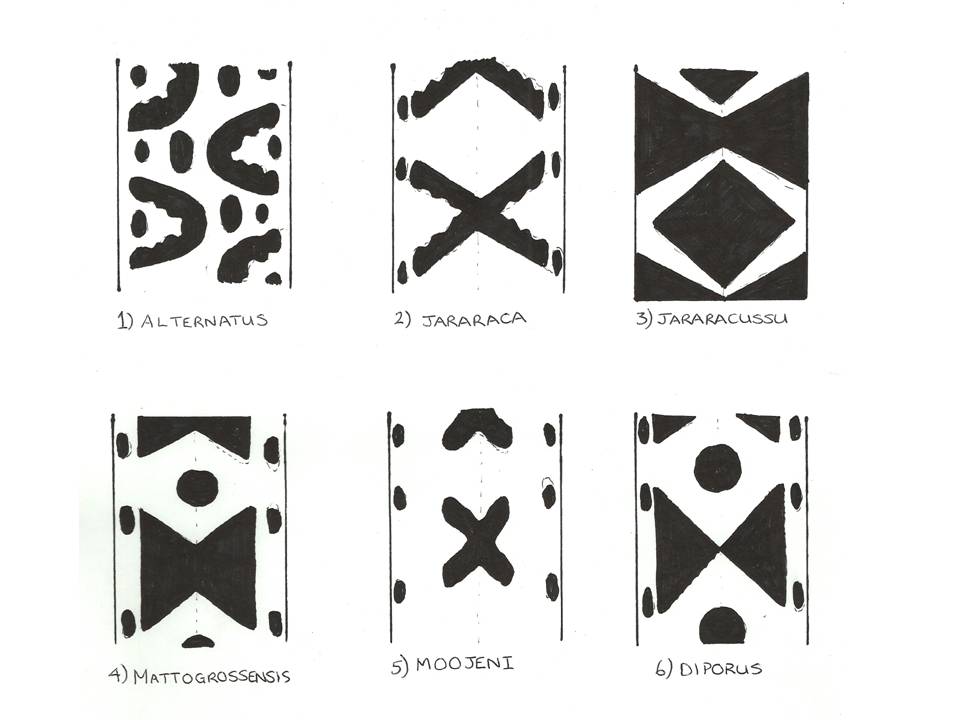
Designed by Paul Smith 2006. This website is copyrighted by law.
Material contained herewith may not be used without the prior written permission of FAUNA Paraguay.
FAMILY VIPERIDAE - VIPERS
Seven species in this family traditionally arranged into two genera Bothops and Crotalus, though a recent revision by Fenwick et al (2009) split the Paraguayan members of the genus Bothrops into three different genera Rhinocerophis, Bothrops and Bothropoides . All Paraguayan Viperids belong to the subfamily Crotalinae. Snakes in this family are highly-venomous and are amongst the most feared snake species on earth. Their haemotoxic venom is fast-acting, attacking both the nervous system and causing multiple organ failure and is responsible for a large number of human fatalities annually.
Vipers typically have a triangular shaped head and keeled scales. The maxilla is short and capable of rotation, bearing one large, hollow, envenomating fang. The maxilla is not in contact with the premaxilla. The premaxilla is toothless.
SUBFAMILY CROTALINAE - RATTLESNAKES AND LANCEHEADS
The Crotalids are identified by the heat-sensitive facial pit located laterally on the head between the eye and the nostril. There is a lateral excavation on the maxilla. Stylised images of typical dorsal patterns are provided for each of the ex-Bothrops species at the bottom of this page, but it should be noted that these species are extremely variable and identification should be made with care.
Key to Adults of Paraguayan Vipers
1a Dorsal pattern consisting of dark vertebral rhomboids bordered by paler lines.............................................. 2
1b Dorsal pattern other, ie dark kidney-shapes, triangles, trapeziums or chevrons............................................. 3
2a Extremely robust and thick body. Romboids blackish-brown, bordered pale and clearly darker than rest of brownish body. Tip of tail with horny "rattle" used as a warning on approach. Widespread in all habitats...........................................................................................................................................Crotalus durissus
2b Overall very dark and blackish. Rhomboids black, bordered with white chevrons that do not meet on lateral line (Fig 3). Rhomboids concolorous with rest of body. Head blackish with white area around mouth and thin white line behind eye. Dorsal head uniform with thin pale lateral lines behind the eye visible dorsally. Atlantic Forest only................................................................................................................................ Bothrops jararacussu
3a Dorsal pattern consisting of large brown kidney-shapes (Fig 1). Dorsal head with well-defined pattern. Mostly dark with four or five large brown patches separated by very thin pale lines. Widespread........................................................................................................................... Rhinocerophis alternatus
3b Dorsal pattern not consisting of large brown kidney-shapes. Dorsal head lacking well-defined pattern of above.....................................................................................................................................................................4
4a Dorsal base colour mostly dark brown, with well-formed, slightly darker, straight-sided lateral trapezoids or triangles, sometimes opposing or sometimes separated by a pale zig-zag pattern...Bothropoides neuwiedii complex 5
4b Dorsal base colour mostly pale greyish-brown, with much darker but poorly-formed lateral chevrons, often reduced to triangular or semi-circular shapes.........................................................................................................6
5a Dorsal pattern broad-topped trapezoid. (Fig 4). Elongated dorsal postcephalic stripe abent, reduced to spots on the head. Dorsolateral spots larger (5-7 scales high)................................................... Bothropoides matogrossensis
5b Dorsal pattern either triangular (Fig 6), or thin-topped trapezoids. Elongated dorsal postcephalic stripe present. Dorsolateral spots smaller (4-5 scales high)................................................................ Bothropoides diporus
da Silva and Rodrigues (2008) reviewed the taxonomy of the widespread speces Bothropoides neuwiedii and split it into a total of seven different species, two of which are present in Paraguay. Only a very small sample of Paraguayan specimens were examined in their analysis. It should be noted that in Paraguayan collections a number of specimens that are apparently intermediate between matogrossensis and diporus according to the diagnostic characters presented by da Silva & Rodrigues exist and the limits of their distribution are by no means clear. Species identification should be performed with caution and it may be better to retain the name B.neuwiedii for both species pending a clarification of the situation. (Norman Scott in litt).
6a Sides of head mostly pale and whitish, with only slightly constrasting broad dark band behind eye. Dark dorsal markings chevron-shaped but often greatly reduced and showing only the tip of the chevron near the vertebral line, well-removed from the lateral spots. (Fig 5). Mainly cerrado................................... Bothrops moojeni
6b Sides of head mostly pale and whitish, with strongly constrasting broad dark band behind eye. Dark dorsal markings chevron-shaped with paler borders, opposing in pattern and sometimes touching to form a wide X-like pattern across the dorsal surface reaching almost as far as the lateral spots (Fig 2). Atlantic Forest........................................................................................................................................Bothropoides jararaca
Juveniles generally resemble paler versions of adults but usually have a pale tip to the tail. Juveniles of B.jararacussu are perhaps the most radically different from their respective adult given the extremely dark colouration of adults, and may be mistaken for species of the neuwiedii complex.
REFERENCES
Caccialli P 2010 - Guía para la Identificación de 60 Serpientes del Paraguay - Guyra Paraguay, Asunción.
Fenwick et al 2009 - Morphological and Molecular Evidence for Phylogeny and Classification of South American Pitvipers, Genera Bothrops, Bothriopsis and Bothrocophias (Serpentes: Viperidae) . Zoological Journal of the Linnean Society 156: p617-640.
Fouquette MJ (unpublished) - Synopsis of Recent Reptiles to Genus - Arizona University
da Silva VX, Rodrigues MF 2008 - Taxonomic Revision of the Bothrops neuwiedii complex (Serpentes, Viperidae) with a Description of a New Species - Phyllomedusa 7: p45-90.
Whitfield P Ed.1984 - Longman Illustrated Animal Encyclopedia - Guild Publishing, London.




